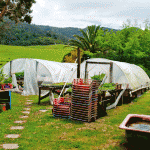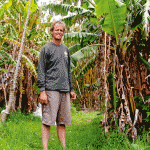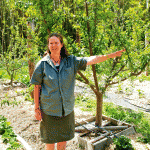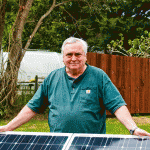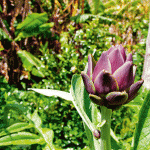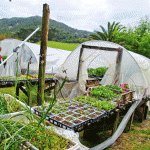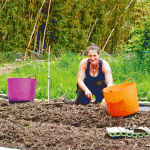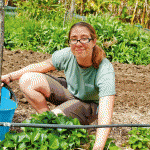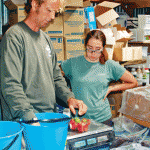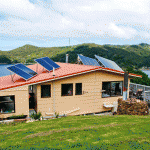Sustainable food producers thinking outside the box on Great Barrier Island
- Plastic houses and wide bamboo shelter belts protect the plants from heavy winds.
- Gerald is the son of famed horticulturist Dick Endt.
- The Endt’s block includes rare tropical fruit trees.
- A purple variety of globe artichoke.
- The Okiwi Passion organic gardens feed a huge number of visitors with pre-packaged boxes, and at the local Tryphena market.
- Wwoofers stay for around two months at a time, but many come back for longer periods.
- Chloe Battaillon, a French wwoofer who has worked at Okiwi Passion three times.
- Surplus fruit and vegetables are boxed up and flown to Auckland for Ooooby customers.
- The Willis’ have a back-up generator but haven’t used it in years, other than to test-run it.
Less than 100km away from the 1.4 million people who make up Auckland is an island of the self-sufficient. Great Barrier Island resident and author Lindsay Wright checks out some of his industrious neighbours.
Words & photos Lindsay Wright
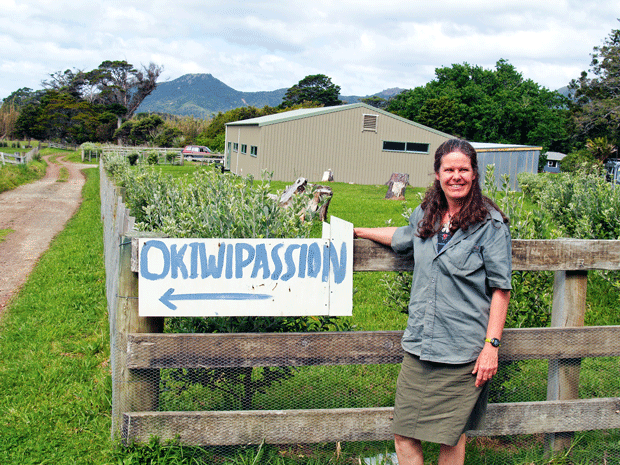
The workforce in Gerald and Caity Endts’ garden start right from scratch. There’s about 75 hens chortling their way contentedly as they fossick through the undergrowth in an overgrown area between towering bamboo wind breaks.
“This paddock was covered in wandering jew until we put the chooks in a few weeks ago – they’ve cleaned it right out,” Gerald says. “We get them from battery farms as pullets so we have to teach them how to roost, and they’re not street wise at all so we keep them close by to prevent predation by hawks or rats.”
But the pampered poultry are only one aspect of this diverse block at the north-east end of the island.
“We’ve been going for seven and a half years, growing a diverse range of fruit and veges, running a busy nursery with organic herb, vege and flower seedlings, and teaching organic gardening workshops to encourage people to grow as much as possible in harmony with nature,” says Caity.
Gerald spent most of his summers with his aunt and uncle, Helen and Murray Mabey, at nearby Whangapoua and cultivated a deep love for the area, the outdoor life, and the hunting and fishing opportunities it provided.
His father, horticulturist Dick Endt, was looking for land to cultivate some of the plants he’d brought back from a trip to South America so he went into partnership with the Mabeys in the 1980s and established the Okiwi Babaco Company. Bamboo shelter belts were planted and an irrigation system installed but the New Zealand palate just wasn’t ready for the sweet, succulent tropical fruit and, after a few years, the partnership was dissolved.
Meanwhile Gerald had been studying horticultural management at Lincoln University and then overseas. He met Caity, who also has a background in horticulture, and imbued her with his love for the Barrier. “So, we eventually arrived on the barge from Auckland with our truck laden to the hilt, ready to get stuck in on our dream garden,” she recalls.
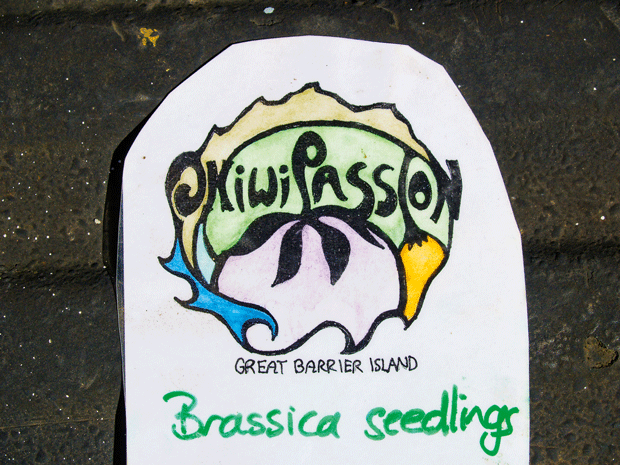
Like most Great Barrier Islanders, the couple had to diversify to earn a living; Caity taught horticulture classes, while Gerald ran a trenching sideline and did some consulting work. Now the productive pair grow enough food to feed an island. Within the microclimate created by the bamboo shelter they grow lettuce and mesclun, tomatoes, eggplants, capsicums, potatoes, chilli, beans, snow peas, sugar snaps, cucumbers, acorn squash, pumpkins, strawberries, zucchini, Florence fennel, carrots, beetroots, baby turnips, silverbeet, spinach, corn, kumara, garlic, spring onion, coriander, parsley, basil and other herbs.
“We grow traditional and open-pollinated heirloom varieties as well as hybrids,” says Caity.
All are spray-free and untreated seed. “We usually grow several varieties of each type of vege and try to grow at least one we haven’t grown before… the difference in colours, textures, sizes and flavours makes life much more interesting for us.”
The pioneering work of Dick Endt is obvious in the fruit orchard with its stands of subtropical fruit: bananas, cherimoya, casimoroa (white sapote), inga beans and lucuma. “The bananas are a variety they grow in the mountains in Samoa, small and sweet,” says Gerald. A fair bit of experimental work goes on too, including mountain coconuts, a native of Ecuador and now extinct in the wild.
The couple enhance the diet of many of the 850 or so Great Barrier Islanders with their weekly vege boxes. Greens imported from town can be half-rotten by the time they get here so the fresh produce in Okiwi Passion’s boxes are famous.
“They hold a variety of seasonal fruit and vegetables, but people let us know what they want. Once we get to know them, we slip in extra treats or maybe some seconds.” Many bach owners order ahead so that their veges are ready when they start their summer holidays. People who miss out can collect their greens from the Okiwi Passion stall at the weekly market day in Tryphena or straight from the farm.
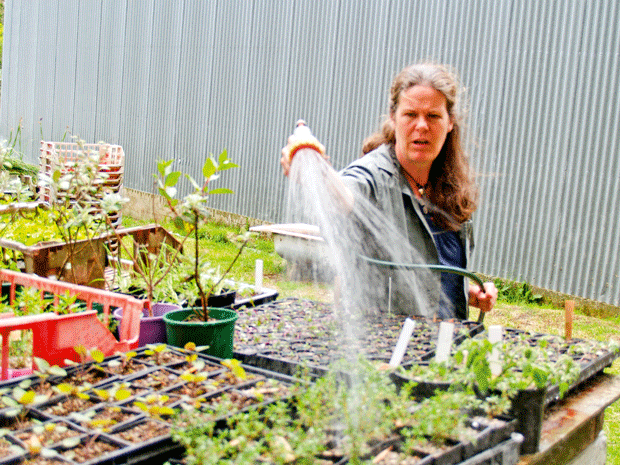
“After the rush of summer people abates we’re left with a surplus. We used to ship to organic outlets in Auckland… but freight is a killer, a drawback of living on a remote island,” says Caity. “Then a grower friend introduced us to Out Of Our Own Backyards (Ooooby), a nationwide organic produce outlet. These guys are awesome to deal with: loyal, communicative, a pleasure to work with a great ethic.”
These days Okiwi Passion’s produce is flown to Auckland, picked up and taken to the Ooooby warehouse for packaging and distribution around the city. “I was at a council meeting the other day and introduced myself to another woman there,” says Caity. “She said ‘ahh, Okiwi Passion, I ate one of your aubergines this week, thanks – it was great.’ I was buzzing by the time I got home to tell Gerald.” There’s a lot more passion in this business than just the name.
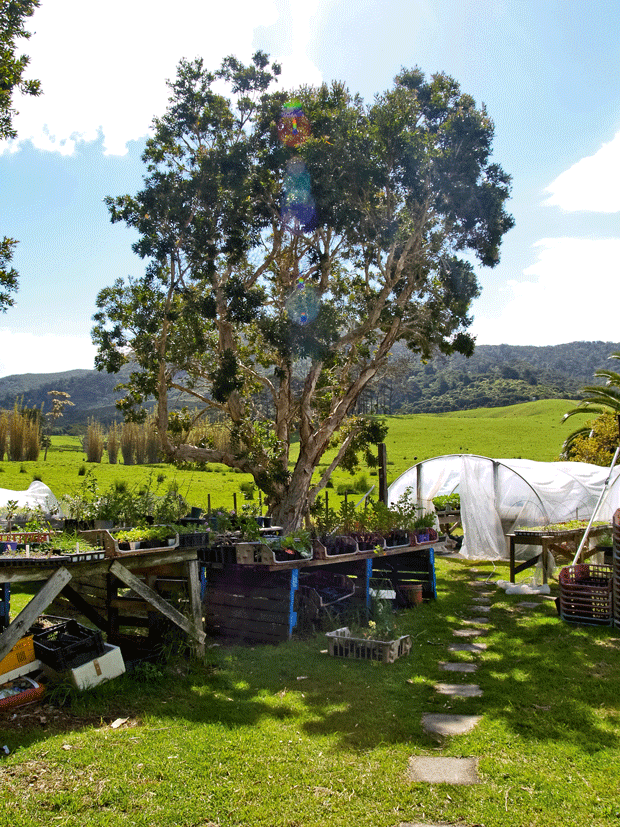
“We hummed and haaed for ages about what to call ourselves,” says Gerald. “Okiwi is the village in north Great Barrier Island where we’re located and the passion part comes from our passion for food, for growing in harmony with nature, for Great Barrier Island and for working with people. Nothing to do with passionfruit.”
Great Barrier Island has no reticulated mains power so Okiwi Passion is run solely by sustainable power, with the exception of a small diesel generator which is run for five hours every second day while Gerald undergoes kidney dialysis treatment, the result of a transplanted organ being rejected in 2007
The couple host up to four WWOOFers (Willing Workers On Organic Farms) from all over the world who help out at any one time. The multicultural workforce are welcomed by locals and work at the garden for two months at a time, although they often return.
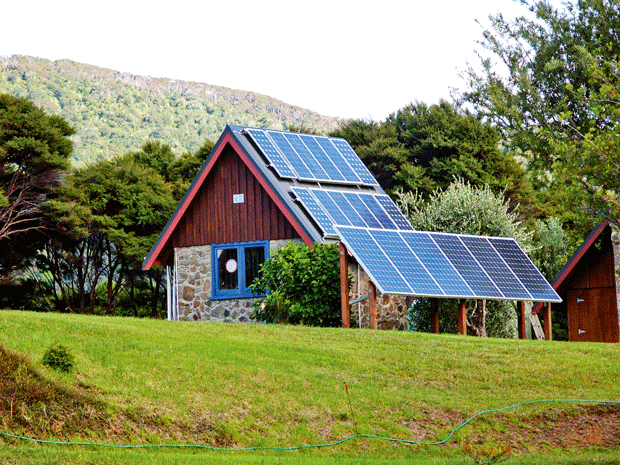
“They’re great, we couldn’t do it without them” says Caity. “We try to teach them as much as we can and hold classes in propagation, grafting and other aspects of the work… we often hear back from them, or they send photos of the gardens they’ve established in the homelands using Okiwi Passion principles.”
The Endts don’t rotary hoe their soil to avoid disturbing its structure. Instead, they mulch bamboo stalks from the wind breaks and grow their produce in compost beds beneath mounds of mulch.
Then there’s the chooks. “Look at that,” says Gerald, making an expansive gesture towards a file of flourishing feijoa trees. “We couldn’t get them to grow because of the bronze beetles. Then we found that the beetles winter over in the ground under the trees and put the chooks in there in late spring, just as the beetles hatched. The chooks eat the larvae and fertilised the trees – which are now thriving – with their droppings, and we took the eggs to market. Magic.”
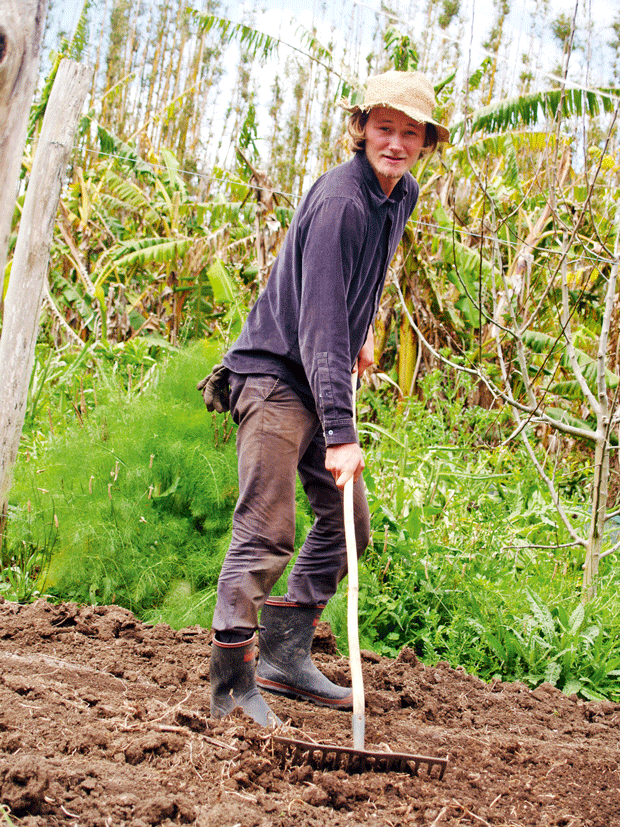
In June 2014, cyclone-strength winds battered the Auckland region. More than 60,000 houses lost electricity and with it, heat, hot water and cooking facilities. Food festered in defunct freezers, traffic lights died and reduced commuter traffic to a cautious crawl, computers became useless, and panic buying stripped supermarket shelves. Civil Defence officials fretted about declaring a state of emergency while power line workers were still struggling, two days later, to reconnect some suburbs.
Almost 100km to the east, Great Barrier Island sustained the same battering.
Almost every road was washed out, and the network of DOC tracks which weave round the convoluted coastline and mountainous hinterland were decimated. But nobody lost power, food stayed frozen and some people rejoiced at the job opportunities that repair work would bring to the island. Afterwards they took to chainsaws and shovels to clean everything up.
Despite its proximity to Auckland, Great Barrier is one of the most remote locations in the country. The journey to Auckland traverses through the frequently turbulent Colville Channel, and residents of the island are imbued with a hardy self-reliance and a pride in their independence. Unlike Stewart Island, where mains power is reticulated from a diesel generation plant, every household on Great Barrier provides its own power.
“It’s part of the Barrier’s tradition of independence and ingenuity,” says Murray Willis, who has installed many of the sustainable energy solutions. “About 500 households on the island are completely self-sufficient in energy, using either solar, wind or water power – I’ve installed about 350 of those.”
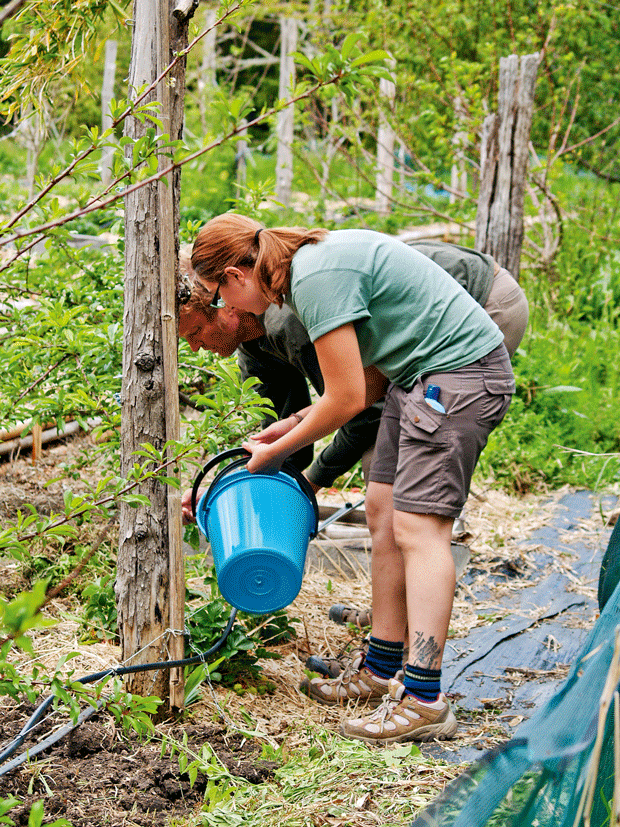
Many of those systems were installed under the auspices of the Rural Electrical Reticulation Council, a 1987 government initiative which used 0.1% from every unit of electricity bought in New Zealand to subsidise power supplies to remote areas.
“It was great,” says Murray. “We were putting power on for people who had only ever used candles or kerosene lamps, and wood fires for cooking. Old ladies who had never had electricity – they would turn the switch on and their faces would be awestruck. They couldn’t stop grinning. They would go away, then come back and switch it on again to make sure it was still working.”
A subsequent government wiped out the scheme so the islanders had to go it alone again, manufacturing their own energy generating systems. Wind generators locally made in the 1970s from washing machine motors and scrap car wheel hubs, with propellers made of aluminium pipe, are still in use.
A few years ago, Great Barrier people were canvassed to find out how many of them would use mains reticulated electricity from the mainland if it was made available. Ninety-eight percent voted to stand alone. “Why change?” asks Murray. “We’re years ahead of the rest of the country.”
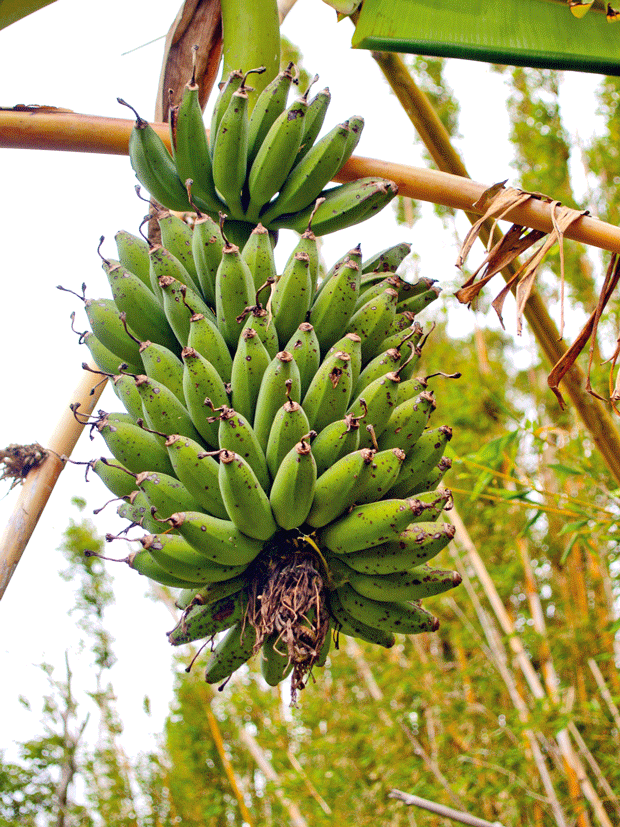
DOC’s island headquarters has been sustainably powered for years, and all the emergency services, including police and Great Barrier Maritime Radio are solar-powered. Murray proudly points to the success of Aotea FM. “We’re the only place in the world with a solar-powered FM radio station,” he says. The delightfully quirky community broadcaster features, among others, Adam from Okupu, Nikki of Angel’s Love of Horses, and Henry’s Happy Hour over 94.6 and 104 mHz frequencies.
“Renewable energy systems are always compared, in price and reliability, with mains power so they have to work properly,” says Murray. “You have to consider the power system as an integral part of the building. The battery capacity is the heart of the system so always use the best quality you can afford.”
He and wife Jan installed a solar and wind powered system at their Whangaparapara cottage 25 years ago and used it to run the power tools needed to build their adjacent house.
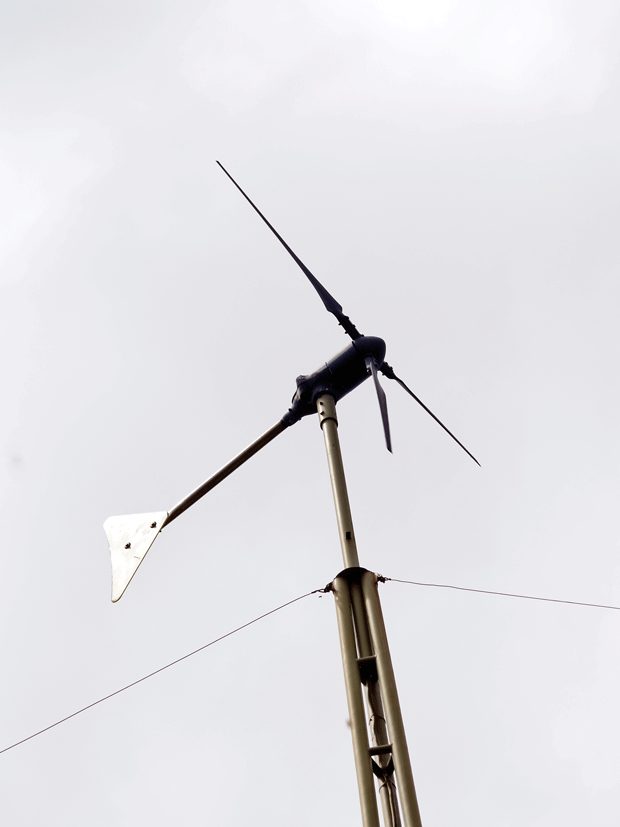
“We’ve got a diesel generator as back up – I start it once a month to make sure it still works – but we haven’t used it in years.” Summer weather has been getting wetter so Murray has also installed a Pelton wheel generator in a nearby creek. “Fridges and lights are the only components made to run off sustainable power,” he says. “Water heating is a big power user. We use a wetback off the wood stove, but we don’t run heat pumps, underfloor heaters, heated towel rails, and haven’t got a heated pool. But so what? That’s a small price to pay for being self-reliant. “In power supply terms, Great Barrier is already where the rest of the western world is struggling, trying to achieve.”
Love this story? Subscribe now!
 This article first appeared in NZ Lifestyle Block Magazine.
This article first appeared in NZ Lifestyle Block Magazine.
